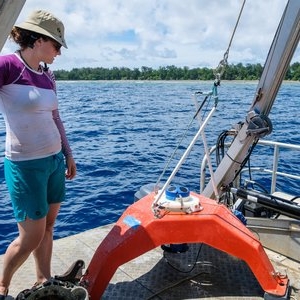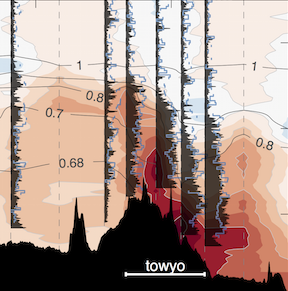FLOW AROUND TOPOGRAPHY
Ocean flows of all frequencies interact with the ocean bottom in a rich variety of ways - depending on whether the sea floor is a headland, a ridge, a submarine canyon - or simply rough with corrugations. Depending on the type of interactions, other motions such as waves and vortices can form and create strong turbulence near the seafloor feature, or at great distance if the motions radiate away. These topographic features can also act as internal wave generators or, oppositely, internal wave guides, funneling and dissipating internal wave energy incident to them.
Figure 1: Abyssal flow through the Samoan Passage (left, black rectangle) as a choke point for the Pacific Overturning Circulation. Measurements of the flow through the main channel (center) show elevated turbulent mixing at two sills (upper right, black profiles) with the coldest deep water completely mixed away (upper right, color). Highly resolved towyo measurements at the second sill show details of turbulent mixing (lower right, color) and lee waves visible in the temperature field (lower right, black)
We employ a variety of tools to measure these types of interactions. For example, in a recent project in the Samoan Passage, we measured some extremely deep “lee waves” (Figure 1) that form as the flow travels through a narrow constriction and over a sill over 5000 m deep. The waves are over 200 m high and create static instabilities in the ocean’s density of similar size, causing mixing and exchange of momentum with the waters above. We have begun observing these types of deep lee waves in several other parts of the world to begin to understand them better. The degree to which these types of breaking waves occur is yet unknown, but is a possible major means by which the ocean’s mean and eddy flows lose energy.
Oscillating tidal motions also interact strongly with topography, giving rise to waves and turbulence near sea-floor ridges (Figure 2) and headlands (Figure 3). Some of the strongest undersea “internal waves” and turbulence arise when tidals flows impinge on two parallel submarine ridges in the Luzon Strait, making waves hundreds of meters high, some of which radiate far into the South China Sea and the Pacific.
Ubiquitous along coastal margins throughout the globe, submarine canyons are a particularly turbulent environment as they can both generate and trap deep-sea internal waves, funneling them shoreward and giving rise to turbulence that can drive upward fluxes of nutrient-rich water toward continental shelf ecosystems
PROJECTS
FLEAT
Flow Encountering Abrupt Topography
Mixing at the margins
Eel canyon / Mendocino Ridge experiment
LaJIT2
La Jolla Internal Tide Experiment
Samoan Passage
A "choke point" in the abyssal circulation





